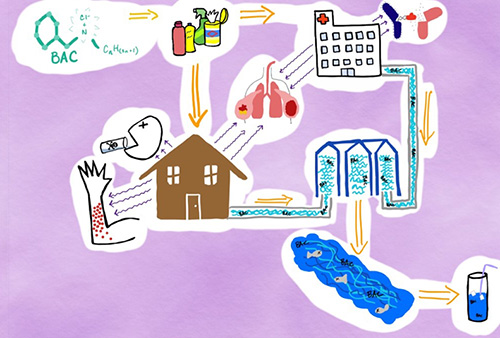Unintended Health Effects of Disinfectant Use Due to COVID

This OpEd article was originally published in The Hill. Click here to see the original publication.
Disinfectant use has skyrocketed recently due to the COVID-19 pandemic. And so has disinfectant misuse, especially of products containing benzalkonium chloride (BAC), revealing some of the dangers associated with these chemicals. As researchers studying the impacts of antimicrobial chemicals in the environment, we think it’s time to reconsider whether BAC belongs in consumer products.
BAC is one of the most common active ingredients in disinfectants. Since the first product containing BAC was registered with the EPA in 1947, its use has risen steeply. And BAC use is pervasive; it is found in a wide range of goods targeted at professionals and consumers alike, but probably the most familiar form for today’s consumers are disinfectant wipes and antibacterial hand soap.
The use of BAC is was already increasing before the pandemic: projections value the market for BAC products at more than $1 billion by 2025, over half of which is accounted for by Europe and North America. The current pandemic has only hastened this process. In fact, the pandemic-induced demand for disinfectants containing BAC was so high, manufacturers had trouble keeping up.
Just as disinfectant use is increasing, so is misuse. Cleaning and disinfectant-related calls to U.S. poison control centers jumped in March and April during the pandemic, with a notable doubling of inhalation exposures to disinfectants. Many of these exposures are likely unintentional just because people are unfamiliar with disinfectants and how to use them properly.
But there have also been high-profile incidences of intentional flagrant misuse of disinfectants. In one particular example, disinfectants containing BAC were over-used in ICE detainment centers, causing nose bleeds and other adverse health effects.
BAC is an important disinfectant in hospital environments. But elsewhere, it can cause more harm than good. The same mechanisms that allow BAC to kill pathogens in hospitals make BAC toxic to aquatic organisms as well as plant and mammalian cells. Researchers have shown that BAC causes acute toxicity in animal studies as well as skin and respiratory irritation in humans. And humans are constantly exposed to BAC because of its ubiquity in our household products and indoor environment.
The primary route of human exposure to BAC is through the skin due to widespread use as a disinfectant. But exposure also occurs through the mouth, eyes, and nose via several processes. For example, continuous nebulized albuterol (CNA) used in pediatric hospitals to increase airflow to the lungs often contains BAC as a preservative. However, due to its effect as a bronchoconstrictor, its inclusion in CNA may in fact be harmful to children and adults with severe asthma. This type of tradeoff can also be seen in hospitals, where healthcare workers are significantly more like to have dermal allergic reactions to BAC, although reactions have occurred in other settings.
Direct exposure to BAC can certainly cause negative reactions, but that’s not the only concern. Antibiotic resistance caused by the widespread use of BAC is significant. Low-level exposure of bacteria to BAC has found to increase the bacteria’s tolerance of BAC up to 500-fold. Our own research has shown that the inclusion of BAC in indoor paints does not completely eliminate viable microbes and in fact, changes which microbes survive on surfaces. Both widespread use of BAC and improper disposal may contribute to release into the environment. Some of the highest concentrations can be found in hospital wastewater. Wastewater treatment facilities are not designed to treat BAC, so they can pass through treatment and be released as micropollutants. BAC has also been detected in soil and food samples, often present in mixtures with other contaminants such as pharmaceuticals. Although environmental concentrations are well below acute human toxicity limits, concerns remain regarding sub-inhibitory concentrations, which can encourage antibiotic resistance.
It is vitally important for us to be able to protect ourselves against infectious disease, and disinfectants like BAC play a critical role in our defense. However, these chemicals are not harmless, nor is their use without consequences. So much BAC use has important impacts on human and environmental health.
Not so long ago, the FDA banned triclosan and so many other antimicrobials from hand soaps, but that ban doesn’t apply to BAC — yet. While the jury is still out, consumers should read the labels on cleaning products, use disinfectants responsibly, and opt for alcohol- or detergent-based products that don’t contain BAC instead. Using BAC safely is a hugely important step in keeping people healthy, ensuring that medical professionals continue to have effective disinfectants, and preventing the next wave of superbugs.
Erica Marie Hartmann is an assistant professor of environmental engineering at Northwestern University, where she studies indoor microbes and how they respond to human-made chemicals. Her research lies at the intersection of public health, microbiology, and the ecology of the built environment.
Olivia Williams Barber, M.S. studies environmental engineering. Her dissertation focused on microbial wastewater treatment.
